
YAMAHA XS750D
A flagship ... and Rightly so.
Original article appeared in Cycle World magazine August, 1976 issue
THERE WAS NO longer room for debate, the motorcycling public had made up its mind that what Yamaha sorely needed was a large‑displacement street machine that could meet the requirements of both touring and sport riding, one preferably in the popular and handy 750cc category, and one, as wishful thinkers craved, with a shaft drive. Yamaha knew if better than anybody and had already begun a full development program that gave rise to the first prototype model in September of 1975.
There are many theories blowing in the breeze as to why Yamaha committed itself to producing a four‑stroke Triple. For one thing, there was certainly no sense in jumping into the foray with all of those other four‑stroke Fours that permeated the marketplace. For another, the side‑to‑side engine harmonies of a four‑stroke Triple are entirely different from the up‑and‑down vibrations of an in‑line Four. Yamaha knew that it would be far wiser to dampen the side‑to‑side rockings than to get a hammerlock on vertical vibes. Another advantage to a Three is a narrower engine width, which aids the machine's angling ability and helps preserve Yamaha's reputation for superior handling street equipment. Finally, Yamaha's Three offers appeal in the things that motorcycling is all about. It is unique in terms of sound, feel, performance, comfort, appearance and handling. Certainly new and different, and most certainly bound for success.
When the largest XS was unveiled last fall at the Yamaha dealer extravaganza, onlookers were met with a paint scheme that elicited mixed emotions. The paint design was revised and the production result is an improvement. Base color is crystal silver, accented with blue on the 4.5-gal. fuel tank, and with black and white striping on the seat, tail section and side panels.
In keeping with the styling themes of the XS500 and the RD400, the 750 is fitted with aluminum wheels that offer more than a cosmetic benefit. Seven spokes are easier to clean than 36 or 40, and although much of the wheel surface is rough cast and won't wipe clean too easily, spraying it off with hot, high pressure soapy water works wonders. Another benefit over spoked wheels is superior wheel rigidity and concentricity.
The advances Yamaha has made of late in street bike suspension shine through on the XS750D. From a touring rider's point of view the Triple's forks and shocks deliver an excellent ride on a par with the example‑setting BMWs.
As revealed by our suspension dyno tests; the Showa forks have 5.5 in. of usable travel, with just about perfect compression and rebound damping. Seal drag is a mere 4 lb., thanks to innovative Teflon fork seals. These all but eliminate static friction on the fork sliders; and the lack of what is normally heavy drag on most forks allows the units to work to their full potential.
While most street bike forks
all but ignore small road undulations, the Showa units glide over pavement
separations and lane divider dots. Since the first two inches of travel soak up
most of the surface irregularities, there's still enough travel left to take
care of large potholes.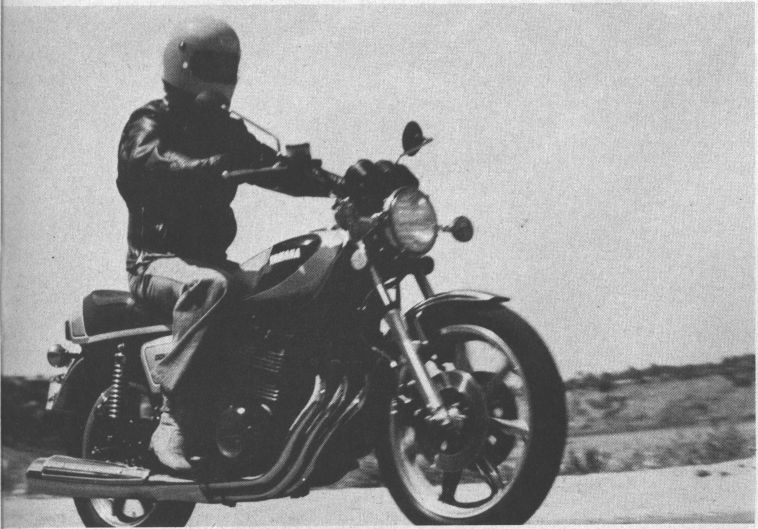
Showa rear shocks have limited oil capacity and only 2.5 in. of travel, but their forward mounting extends wheel travel another inch. We were surprised to learn that rebound damping wasn't higher than usual. Since rear drive torque reaction tends to lift the rear of a bike under acceleration (just the opposite of what a conventional chain drive does), we expected fairly high rebound damping to keep the reins on that phenomenon. But it wasn't there, though compression damping at 15 lb. is on the high side, as is the 125‑lb. rear spring rate.
If the bike were lighter, those high rates might make, for a harsh ride. But the ride is smooth and soft, just about ideal for general riding, touring or commuting. Add a passenger and/or a good bit of luggage, though, and the shocks will be overworked. Riders who like nothing better than laying footpeg rubber in the turns will have a few complaints, as well.
First there is the matter of the rear shocks. But that can be easily remedied by switching to a quality accessory brand. The matter of right side cornering clearance won't be solved quite so easily, however at least until the aftermarket people have a chance to design and build an exhaust system with some elbow room between muffler and pavement, something the stock three-into-one arrangement does not have.
A few years back Yamaha would have been able to make a dandy of a tucked in exhaust system, but with federal regs specifying an 83 dbA limit on street machinery, we have to live with the giant muffler as standard equipment. Fortunately there's a mellow enough sound coming through to reveal the engine as a Three rather than a vacuum cleaner with a head cold, which is just the way a certain few motorcycles are beginning to sound.
 Collector exhausts seem to be
de rigueur these days, but we would have preferred a
system whose center pipe splits and heads into the two remaining individual
pipes, a la the Triumph Triples. Two advantages would have resulted:
better angling ability for both right and left hand cornering, and a more
balanced look on both sides of the machine. As it is now, the single muffler
appears ungainly on the right side, while the left side of the 750 looks naked.
Collector exhausts seem to be
de rigueur these days, but we would have preferred a
system whose center pipe splits and heads into the two remaining individual
pipes, a la the Triumph Triples. Two advantages would have resulted:
better angling ability for both right and left hand cornering, and a more
balanced look on both sides of the machine. As it is now, the single muffler
appears ungainly on the right side, while the left side of the 750 looks naked.
For riders who'd rather do anything but head in a straight line, there's a pretty painless way to raise the overall height of the 750. All they need do is jack up the standard rear shocks to their maximum preload and slide the front forks down about a half‑inch by loosening the pinch bolts in the triple clamps. Shorter riders will be a little uncomfortable with the increased height when stationary, but anyone who wants to play Steve Baker has slightly lessened the chances of punching the pavement ... without detriment to straight line stability.
The standard Bridgestone tires work fine for most riders' purposes, but the rubber up front is ribbed, causing the machine to "hunt" over rain grooved highways. While the block pattern tire at the rear doesn't have such an acute tendency to "chase" the grooves, there's a different kind of hangup back there. Trying to fit a larger or low profile type tire that is wider than standard just won't work because the driveshaft tube that doubles as the left side of the swinging arm offers very little tire clearance ... even in spite of the "dimple" put in the tube at the factory to create additional clearance.
Changing a tire won't be too big a deal if the need ever arises. With the seat in the "up" position, the loosening of two bolts will allow the rear fender to pivot up out of the way on a built‑in hinge. Nearly everything else stays right where it belongs: the brake caliper on the machine and the rotor with the wheel. The left caliper up front does have to be loosened, but no trouble should arise if the owner follows the sequence outlined in the fairly complete owner's manual.
Having tested all but one of Yamaha's newest street‑going motorcycles, we've become quite accustomed to their instrumentation and switch and handlebar control locations. We think they're among the best in the industry, right down to the self‑canceling turn indicators, which we hope to see on all machines someday. We like the ignition switch location right up in the center between the tachometer and speedometer, the perfect placement of headlight and dimmer switches, and the ideal handgrips. About the only thing to hope for in the future is non‑glare plastic instrument faces. And let's not forget amber turn signal lenses at the rear for greater visibility in heavy nighttime traffic.
While the 750's entire
appearance exudes the kind of class that's usually spelled out in dollar signs,
its moderate price tag of $2236 puts it within $50 of its direct competition,
the Honda CB750F, which lacks a shaft drive.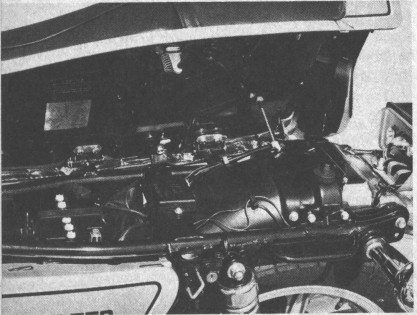
Our feelings of admiration for the new XS could only increase when we began taking an even closer look at the power train. To put it mildly, we were pumped. It would be difficult for anyone even remotely interested in motorcycles not to give this one a good, strong stare. And the temptation to climb aboard and give it a whirl is stronger yet.
When that time comes, what will greet the rider is an unprecedented smoothness for a bike of this configuration. While the XS750 shares with its four-stroke Triple predecessors ‑ the Triumph Trident and Kawasaki H2 ‑ crankshaft throws that are spaced 120 degrees apart, it never reaches their "shake and bake" levels of vibration. What's more, it is smoother even than the Honda 750 and Kawasaki 900 Fours with which it will inevitably be compared.
It is obvious that Yamaha has found a way to rubber mount the Triple in a manner that prevents annoying low rpm shake and yet holds down cruising speed buzzing. Rubber mounted bars do their part in the action, to be sure, but one never gets the feeling of vagueness that often accompanies the resilient effects of rubber.
Only a cost accounting dullard would find fault with the engine's outward appearance, which is resplendent in black with buffed cylinder finning and polished highlights. DOHC towers peek under the fuel tank, which is sculpted inward to provide clearance. The black engine reminded us of the original Kawasaki Z1, which lost a touch of class when the black disappeared in later models. Hopefully Yamaha will keep the Triple in mourning throughout subsequent model runs.
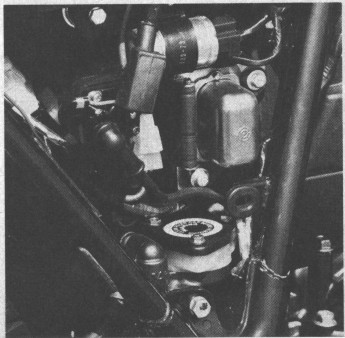 Inside,
as deep as you care to go things have been designed to stay reliable for a long
time to come. The crankshaft is a one‑piece forging instead of a pressed
together affair, and it is supported by four automotive type bearings.
Connecting rods are also forged and carry plain inserts on their big ends. The
small ends are copper plated rather than having pressed‑in bushings.
Inside,
as deep as you care to go things have been designed to stay reliable for a long
time to come. The crankshaft is a one‑piece forging instead of a pressed
together affair, and it is supported by four automotive type bearings.
Connecting rods are also forged and carry plain inserts on their big ends. The
small ends are copper plated rather than having pressed‑in bushings.
The overhead camshafts are driven off the left side of the crank by a single‑row chain. Access for adjustment is provided through the cylinder casting. The XS750 uses a "direct valve train system," whereby the cam lobes are located directly above the valves and move them up and down without the use of rocker arms. Valve clearances are adjusted by changing thicknesses of adjusting pads in accordance with a chart and the existing valve adjustment.
In addition to its other duties, the crank also manages to gear‑drive a trochoidal oil pump, the ignition's contact breaker cam and, of course, transmit power via a Hy‑Vo chain to the clutch assembly. Cruising speed oil pressure with the engine at operating temperature is 42 psi. Engine oil level may be checked with a built‑in dipstick. The baffled sump requires 3.38 qt. of oil with a filter change.
Clutch pull at the lever is medium light. Feeding out the lever produces no sudden lurch or grab and engagement occurs early in the lever's travel. An additional support bearing on the clutch assembly's outer side ensures toughness; the clutch hub contains a drive shock cushion, as well.
The five‑speed gearbox was the ideal choice for this model. Gear selection with the foot will feel different than on other Yamaha models and will take some getting used to before the shifting action is comfortable. It's not a "snick, snick" gearbox, but rather one that may require a touch of concentration for a time. Downshifting demands a deft hand to coordinate throttle rpm with road speed because shaft‑driven bikes couple up soundly when the clutch is released.
To help smooth out the action
of the clutch, Yamaha has installed a cushioning device in the cross shaft which
connects the gearbox output shaft with the spiral bevel gears that connect to
the driveshaft. The casing in which these gears are located is the spot where
most motorcycles house their primary drive sprockets.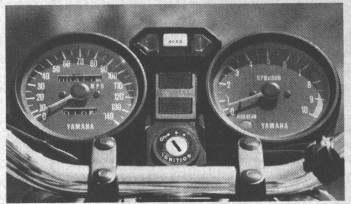
Checking the oil level in this middle gear case, as well as in the final drive case at the rear wheel, is done with a small, plastic dipstick that is stored in the very complete toolkit when not in use.
At the swinging arm's pivot point, a special (and expensive) constant velocity U‑joint of the type often found in front wheel drive cars is used. The unit is permanently lubricated and sealed; an accordion‑like rubber cover fits around the outside of the casings to help keep dirt away and dress up the complicated connection.
The final drive is, of course, a ring and pinion assembly that requires an oil change every 6000 miles. The rear housing holding the final drive gears is of alloy with an attractive outer finish. The entire drive system will require very little attention as the miles roll on, making it all the more desirable for the touring rider.
All motorcycles need a mechanic's attention at some time ... and Yamaha has devoted much research to making the job easier and faster when that time comes. For one thing, all electrical components are first rate. And this model will also allow a full top‑end job ‑ removal of cylinder head, cylinders and related pieces ‑ without removal of the engine from the frame. That can save a great deal of money when a rebuild becomes necessary.
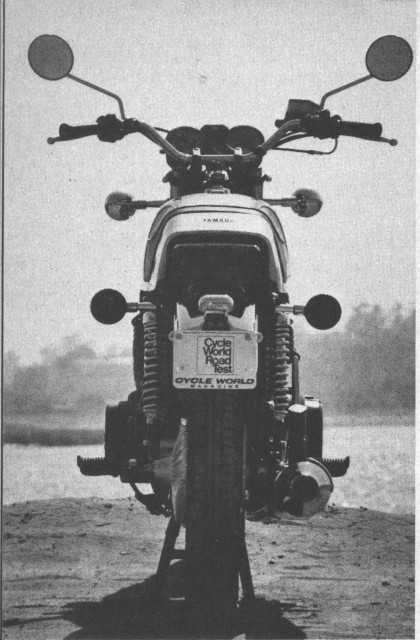 Constant velocity carburetors
are made by Mikuni and are 34mm in size. A dry foam filter is easily accessible
in the large plastic airbox unit and can be cleaned by blowing dirt particles
off with an air hose from the inside of the element. Standard idle speed is 1100
rpm, but the idle mixture is permanently set at the factory.
Constant velocity carburetors
are made by Mikuni and are 34mm in size. A dry foam filter is easily accessible
in the large plastic airbox unit and can be cleaned by blowing dirt particles
off with an air hose from the inside of the element. Standard idle speed is 1100
rpm, but the idle mixture is permanently set at the factory.
The CV carbs automatically adjust the slide position over the fuel nozzle no matter how quickly the throttle is wicked open. Mid‑range response is thus improved, but rolling the throttle from idle to even part way open produces a sudden surge of power that makes it difficult to pull away smoothly. Couple this with a fair amount of drive train snatch and it's easy to see that a precise throttle hand and some practice are in order.
Performance of the 750 won't be setting speed records around the country, but then it wasn't built for that purpose. The engine is actually quite mild in standard trim, built for tractability and dependability, though it probably won't be long before the speed guys get going on goodies for the horsepower‑oriented rider.
There is no question that this Yamaha is a flagship. It will accomplish many things for many different riders. Although we'd like to see better ground clearance and a reduction in weight, the Yamaha XS already stands at the top of the 750 class and is good enough to be considered among the world's top touring equipment, regardless of displacement.